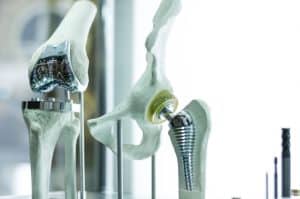What to Expect From a Hip or Knee Revision: Understanding the Need, Treatment, and Recovery Process for Patients
Prodromos Ververeli, MD and Susan Dieter MS, RN, CWS

Facing the need for a hip or knee revision can be an overwhelming experience. However, understanding the reasons behind the revision, what to expect from the treatment itself, and the recovery process can empower patients to approach the procedure with confidence. This article aims to provide patients with information about hip or knee revision, shedding light on the indications for the procedure, the treatment process, and the anticipated recovery journey.
Why is Revision Surgery Necessary?

Hip or knee revision surgery becomes necessary when a previously implanted joint replacement device requires repair or replacement due to various factors, including:
Wear and Tear: Over time, the artificial joint can experience normal wear and tear, leading to the deterioration of components such as the bearing surface (similar to the eventual wear of your car tire treads) or the implant mechanism that sure cure the implant to the bone.
Loosening: Sometimes, the components of the original implant may loosen or become detached from the bone, causing pain, instability, and reduced joint function2.
Trauma: Occasionally, a forceful injury may cause an instability of the ligament structures or a fracture of the bone supporting the implant. This would result in activity related pain or dislocation requiring a revision surgery.
Infection: Infection can occur around the joint replacement, leading to persistent pain, swelling, and compromised joint function. In some cases, treating the infection requires removing and replacing the implant3.
Implant Failure: Occasionally, joint replacement implants may fail due to due to component damage from repetitive movement of the mechanical parts with loosening or change in alignment, necessitating revision surgery4.
The Treatment Process:

Preoperative Evaluation: Before the revision surgery, your healthcare team will conduct a thorough evaluation, including a physical examination, imaging studies (X-rays, CT, MRI, etc.), and possibly blood tests. This assessment helps determine the extent of the problem and develop a personalized surgical plan.
Anesthesia: Most hip or knee revision surgeries are performed under regional anesthesia with sedation, ensuring that you remain asleep and pain-free throughout the procedure.
Surgical Procedure: During the revision surgery, the surgeon will remove the old implant, address any bone erosion or instability, and replace it with a new implant. The specific steps and techniques involved will depend on your unique situation.
Recovery Process
Hospital Stay: Following surgery, you will typically stay in the hospital for a few days to monitor your recovery, manage pain, and initiate rehabilitation5.
Rehabilitation: Physical therapy plays a vital role in the recovery process. A physical therapist will work with you to regain joint mobility, strength, and function. Rehabilitation may start in the hospital and continue as outpatient sessions or home exercises6.
Gradual Return to Activities: Your surgeon and physical therapist will guide you through a step-by-step process of gradually increasing activities and weight-bearing based on your progress. It is essential to follow their instructions and maintain regular follow-up appointments.
Pain Management: Pain and discomfort are common after revision surgery. Your healthcare team will provide medications and strategies to help manage pain effectively.
Healing and Recovery Time: The complete recovery period varies from patient to patient but can take several months. It is important to be patient, follow rehabilitation guidelines, and communicate any concerns or setbacks with your healthcare team.
Hip or knee revision surgery is a complex but necessary procedure to address issues with a previous joint replacement. By understanding the reasons for revision, the treatment process, and the recovery journey, patients can approach the procedure with confidence and actively participate in their own recovery. Open communication with the healthcare team, following rehabilitation guidelines, and maintaining a positive mindset can greatly contribute to a successful outcome and improved quality of life after hip or knee revision surgery.
To learn more about Sanara MedTech products, please visit. https://sanaramedtech.com/surgical/
References:
1. Ries MD. Revision total hip arthroplasty: indications and principles. J Am Acad Orthop Surg. 2005;13(2):131-138. doi:10.5435/00124635-200503000-00008 ↩
2. Abdel MP, Stryker LS, Trousdale RT, et al. Preoperative identification of modifiable risk factors in primary and revision total knee arthroplasty. J Bone Joint Surg Am. 2011;93(5):389-394. doi:10.2106/jbjs.i.01785 ↩
3. Osmon DR, Berbari EF, Berendt AR, et al. Diagnosis and management of prosthetic joint infection: clinical practice guidelines by the Infectious Diseases Society of America. Clin Infect Dis. 2013;56(1):e1-e25. doi:10.1093/cid/cis803 ↩
4. Barrack RL. Why are total knee arthroplasties being revised? Bone Joint J. 2016;98-B(1 Suppl A):17-20. doi:10.1302/0301-620X.98B1.36640 ↩
5. Fehring TK, Odum SM, Berend KR, Jiranek WA, Parvizi J, Bozic KJ. Failure of irrigation and débridement for early postoperative periprosthetic infection. Clin Orthop Relat Res. 2013;471(1):250-257. doi:10.1007/s11999-012-2541-5 ↩
6. Husted H, Otte KS, Kristensen BB, et al. Low risk of thromboembolic complications after fast-track hip and knee arthroplasty. Acta Orthop. 2010;81(5):599-605. doi:10.3109/17453674.2010.492350 ↩




